Stress Evaluation in Endodontically Treated Virtual Teeth Restored with Composite Fillings and Cast or Fiberglass Posts—A Finite Element Analysis
Abstract
:1. Introduction
2. Materials and Methods
2.1. Human Tooth
2.2. Virtual Tooth Models
- -
- Model no. 1: Molar without endodontic treatment, containing enamel, dentin, pulp and cementum;
- -
- Model no. 2: Molar after endodontic treatment, containing enamel, dentin and cementum, with a gutta-percha root canal filling and composite filling;
- -
- Model no. 3: Molar after endodontic treatment, containing enamel, dentin and cementum, with gutta-percha root canal filling, restored with fiberglass post, composite filling and monolithic zirconia crown;
- -
- Model no. 4: Molar after endodontic treatment, containing enamel, dentin and cementum, with gutta-percha root canal filling, restored with a chromium–nickel alloy post and monolithic zirconia crown.
2.3. Hardware, Software and Appliances
2.4. The Creation of the Virtual Molars
- -
- Methods and principles of Continuum Mechanics applied to operating with Multi Body virtual solids;
- -
- Techniques and methods specific to the strength of the materials applied to defining loading systems and modeling mechanical constraints;
- -
- Methods and principles of Computer-Aided Design (CAD) and Direct Engineering and Virtual Prototyping applied to modeling the composite and posts;
- -
- Methods and techniques of reverse engineering applied to the three-dimensional scanning of the analyzed molar and the metal post;
- -
- Techniques and methods specific to the Finite Elements Method (FEM) applied to the studied models to determine the mechanical behavior [30];
- -
2.5. Assignation of Properties of the Materials Used to the Virtual Models
- Displacement state provides information on the variation in node positions of the finite elements, expressed in meters (m);
- Strain state was evaluated using von Mises criterion, representing the elongation of finite elements relative to the unit of length, expressed in meters per meter (m/m);
- Stress state was determined using von Mises algorithm which quantifies the loading of finite elements by relating force to surface, expressed in Pascals (1 Pa = 1 N/m2).
2.6. Statistical Analysis
3. Results
3.1. Simulation of the Action of Excessive Occlusal Forces
3.2. Numerical Results Obtained from the Simulation
3.2.1. Numerical Results for Model No. 1
3.2.2. Numerical Results for Model No. 2
3.2.3. Numerical Results for Model No. 3
3.2.4. Numerical Results for Model No. 4
3.3. Comparison of Displacements, Strains and Stresses Obtained in the Simulations of the Action of Horizontal Forces
3.4. Statistical Analysis of Stress in Virtual Models
3.5. Determining When the Force Becomes Critical
4. Discussion
5. Conclusions
Author Contributions
Funding
Institutional Review Board Statement
Informed Consent Statement
Data Availability Statement
Conflicts of Interest
Abbreviations
| DMA | Dento-maxillary apparatus |
| FEM | Finite Element Method |
| 3D | Three-dimensional |
References
- López-Valverde, I.; Vignoletti, F.; Vignoletti, G.; Martin, C.; Sanz, M. Long-term tooth survival and success following primary root canal treatment: A 5- to 37-year retrospective observation. Clin. Oral Investig. 2023, 27, 3233–3244. [Google Scholar] [CrossRef] [PubMed]
- Fransson, H.; Dawson, V. Tooth survival after endodontic treatment. Int. Endod. J. 2023, 56 (Suppl. S2), 140–153. [Google Scholar] [CrossRef] [PubMed]
- Boțilă, M.R.; Țuculină, M.J.; Diaconu, O.A.; Ionescu, M.; Mărășescu, P.C.; Lascu, L.C.; Mercuț, V. Retrospective study of the evolution of teeth with endodontic treatment in a group of patients from Craiova- România. Rom. J. Oral Rehabil. 2024, 16, 225–243. [Google Scholar] [CrossRef]
- Gheorghe, A.G.; Mercuț, V.; Popescu, S.M.; Banica, A.C.; Ionescu, M.; Gheorghiță, L.M.; Moraru, A. Frequency of endodontic treatment and prevalence of apical periodontitis in abutment teeth—A radiological study. Rom. J. Oral Rehabil. 2019, 11, 11–20. [Google Scholar]
- Moris, I.C.M.; Moscardini, C.A.; Moura, L.K.B.; Silva-Sousa, Y.T.C.; Gomes, E.A. Evaluation of Stress Distribution in Endodontically Weakened Teeth Restored with Different Crown Materials: 3D-FEA Analysis. Braz. Dent. J. 2017, 28, 715–719. [Google Scholar] [CrossRef]
- Monga, P.; Sharma, V.; Kumar, S. Comparison of fracture resistance of endodontically treated teeth using different coronal restorative materials: An in vitro study. J. Conserv. Dent. 2009, 12, 154–159. [Google Scholar] [CrossRef]
- Bănică, A.C.; Marinescu, I.R.; Gheorghe, D.N.; Trușcă, A.G.; Drăghici, E.C.; Mercuț, V.; Popescu, S.M. Root resorbtion prevalence in adults from Dolj county, Romania- A radiological evidence. Rom. J. Oral Rehabil. 2018, 10, 170–179. [Google Scholar]
- Chieruzzi, M.; Pagano, S.; De Carolis, C.; Eramo, S.; Kenny, J.M. Scanning Electron Microscopy Evaluation of Dental Root Resorption Associated with Granuloma. Microsc. Microanal. 2015, 21, 1264–1270. [Google Scholar] [CrossRef]
- Kalra, H.; Sukhija, U.; Rassawet, R.; Rani, V. A Review on Post and Core. Sch. J. Dent. Sci. 2020, 07, 51–56. [Google Scholar] [CrossRef]
- Tang, W.; Wu, Y.; Smales, R.J. Identifying and reducing risks for potential fractures in endodontically treated teeth. J. Endod. 2010, 36, 609–617. [Google Scholar] [CrossRef] [PubMed]
- Larson, T.D. The effect of occlusal forces on restorations. J. Mich. Dent. Assoc. 2014, 96, 38–47. [Google Scholar] [PubMed]
- Sagl, B.; Schmid-Schwap, M.; Piehslinger, E.; Kundi, M.; Stavness, I. Effect of facet inclination and location on TMJ loading during bruxism: An in-silico study. J. Adv. Res. 2022, 35, 25–32. [Google Scholar] [CrossRef] [PubMed]
- Sagl, B.; Schmid-Schwap, M.; Piehslinger, E.; Rausch-Fan, X.; Stavness, I. The effect of tooth cusp morphology and grinding direction on TMJ loading during bruxism. Front. Physiol. 2022, 13, 964930. [Google Scholar] [CrossRef]
- Sarıkaya, I.; Hayran, Y. Effects of dynamic aging on the wear and fracture strength of monolithic zirconia restorations. BMC Oral Health 2018, 18, 146. [Google Scholar] [CrossRef]
- Fan, J.; Caton, J.G. Occlusal trauma and excessive occlusal forces: Narrative review, case definitions, and diagnostic considerations. J. Periodontol. 2018, 89 (Suppl. S1), S214–S222. [Google Scholar] [CrossRef]
- Vlăduțu, D.E.; Ionescu, M.; Mercuț, R.; Noveri, L.; Lăzărescu, G.; Popescu, S.M.; Scrieciu, M.; Manolea, H.O.; Iacov Crăițoiu, M.M.; Ionescu, A.G.; et al. Ecological Momentary Assessment of Masseter Muscle Activity in Patients with Bruxism. Int. J. Environ. Res. Public Health 2022, 20, 581. [Google Scholar] [CrossRef]
- Viola, C.; Muñoz-Corcuera, M.; Antoranz-Pereda, A.; Casañas, E.; Navarrete, N. Time assessment for final restoration of endodontically treated teeth in a university clinic setting: An observational study. Saudi Dent. J. 2024, 36, 621–626. [Google Scholar] [CrossRef]
- Maravić, T.; Comba, A.; Mazzitelli, C.; Bartoletti, L.; Balla, I.; di Pietro, E.; Josić, U.; Generali, L.; Vasiljević, D.; Blažić, L.; et al. Finite element and in vitro study on biomechanical behavior of endodontically treated premolars restored with direct or indirect composite restorations. Sci. Rep. 2022, 12, 12671. [Google Scholar] [CrossRef]
- Upadhyaya, V.; Bhargava, A.; Parkash, H.; Chittaranjan, B.; Kumar, V. A finite element study of teeth restored with post and core: Effect of design, material, and ferrule. Dent. Res. J. 2016, 13, 233–238. [Google Scholar] [CrossRef]
- Toksavul, S.; Zor, M.; Toman, M.; Güngör, M.A.; Nergiz, I.; Artunç, C. Analysis of dentinal stress distribution of maxillary central incisors subjected to various post-and-core applications. Oper. Dent. 2006, 31, 89–96. [Google Scholar] [CrossRef]
- Sharafeddin, F.; Alavi, A.A.; Zare, S. Fracture resistance of structurally compromised premolar roots restored with single and accessory glass or quartz fiber posts. Dent. Res. J. 2014, 11, 264–271. [Google Scholar]
- Alshabib, A.; Abid Althaqafi, K.; AlMoharib, H.S.; Mirah, M.; AlFawaz, Y.F.; Algamaiah, H. Dental Fiber-Post Systems: An In-Depth Review of Their Evolution, Current Practice and Future Directions. Bioengineering 2023, 10, 551. [Google Scholar] [CrossRef]
- Nahar, R.; Mishra, S.K.; Chowdhary, R. Evaluation of stress distribution in an endodontically treated tooth restored with four different post systems and two different crowns—A finite element analysis. J. Oral Biol. Craniofac. Res. 2020, 10, 719–726. [Google Scholar] [CrossRef] [PubMed]
- Oladapo, B.; Zahedi, A.; Vahidnia, F.; Ikumapayi, O.; Farooq, M. Three-dimensional finite element analysis of a porcelain crowned tooth. Beni-Suef Univ. J. Basic Appl. Sci. 2018, 7, 461–464. [Google Scholar] [CrossRef]
- Lin, J.; Lin, Z.; Zheng, Z. Effect of different restorative crown design and materials on stress distribution in endodontically treated molars: A finite element analysis study. BMC Oral Health 2020, 20, 226. [Google Scholar] [CrossRef] [PubMed]
- Silva, N.R.; Castro, C.G.; Santos-Filho, P.C.; Silva, G.R.; Campos, R.E.; Soares, P.V. Influence of different post design and composition on stress distribution in maxillary central incisor: Finite element analysis. Indian J. Dent. Res. 2009, 20, 153–158. [Google Scholar]
- Stănuși, A.Ș.; Popa, D.L.; Ionescu, M.; Cumpătă, C.N.; Petrescu, G.S.; Ţuculină, M.J.; Dăguci, C.; Diaconu, O.A.; Gheorghiță, L.M.; Stănuşi, A. Analysis of Temperatures Generated during Conventional Laser Irradiation of Root Canals-A Finite Element Study. Diagnostics 2023, 13, 1757. [Google Scholar] [CrossRef]
- Bessone, L.; Fernandez, B.E., Jr. Evaluation of different post systems: Finite element method. Int. J. Odontostomat. 2010, 4, 229–236. [Google Scholar] [CrossRef]
- Pierrisnard, L.; Bohin, F.; Renault, P.; Barquins, M. Coronoradicular reconstruction of pulpless teeth: A mechanical study using finite element analysis. J. Prosthet. Dent. 2002, 88, 442–448. [Google Scholar] [CrossRef]
- Boțilă, M.R.; Popa, D.L.; Mercuț, R.; Iacov-Crăițoiu, M.M.; Scrieciu, M.; Popescu, S.M.; Mercuț, V. A Finite Element Method Study of Stress Distribution in Dental Hard Tissues: Impact of Access Cavity Design and Restoration Material. Bioengineering 2024, 11, 878. [Google Scholar] [CrossRef]
- Available online: https://www.3dsystems.com (accessed on 20 August 2024).
- Available online: https://www.solidworks.com (accessed on 22 September 2024).
- Available online: https://www.ansys.com (accessed on 15 October 2024).
- Maksay, S.T.; Bistrian, D.A. Introducere în Metoda Elementelor Finite; Editura CERMI Iasi: Iași, Romania, 2008; ISBN 978-973-667-324-5. [Google Scholar]
- Mannocci, F.; Cowie, J. Restoration of endodontically treated teeth. Br. Dent. J. 2014, 216, 341–346. [Google Scholar] [CrossRef] [PubMed]
- McComb, D. Restoration of the Endodontically Treated Tooth; The Royal College of Dental Surgeons of Ontario: Toronto, ON, Canada, 2008. [Google Scholar]
- Staicu, A.N.; Țuculină, M.J.; Cumpătă, C.N.; Rîcă, A.M.; Beznă, M.C.; Popa, D.L.; Popescu, A.D.; Diaconu, O.A. A Finite Element Method Study on a Simulation of the Thermal Behaviour of Four Methods for the Restoration of Class II Cavities. J. Funct. Biomater. 2024, 15, 86. [Google Scholar] [CrossRef] [PubMed]
- Petrescu, S.M.; Rauten, A.M.; Popescu, M.; Popescu, M.R.; Popa, D.L.; Ilie, D.; Duță, A.; Răcilă, L.D.; Vintilă, D.D.; Buciu, G. Assessment of Thermal Influence on an Orthodontic System by Means of the Finite Element Method. Bioengineering 2024, 11, 1002. [Google Scholar] [CrossRef] [PubMed]
- Popescu, A.D.; Popa, D.L.; Nicola, A.G.; Dascălu, I.T.; Petcu, C.; Tircă, T.; Tuculina, M.J.; Mocanu, H.; Staicu, A.N.; Gheorghiță, L.M. Post Placement and Restoration of Endodontically Treated Canines: A Finite Element Analysis Study. Int. J. Environ. Res. Public Health 2022, 19, 8928. [Google Scholar] [CrossRef]
- Zarow, M.; Vadini, M.; Chojnacka-Brozek, A.; Szczeklik, K.; Milewski, G.; Biferi, V.; D’Arcangelo, C.; De Angelis, F. Effect of Fiber Posts on Stress Distribution of Endodontically Treated Upper Premolars: Finite Element Analysis. Nanomaterials 2020, 10, 1708. [Google Scholar] [CrossRef]
- Benazzi, S.; Nguyen, H.N.; Kullmer, O.; Kupczik, K. Dynamic Modelling of Tooth Deformation Using Occlusal Kinematics and Finite Element Analysis. PLoS ONE 2016, 11, e0152663. [Google Scholar] [CrossRef]
- Cicciù, M.; Cervino, G.; Bramanti, E.; Lauritano, F.; Lo Gudice, G.; Scappaticci, L.; Rapparini, A.; Guglielmino, E.; Risitano, G. FEM Analysis of Mandibular Prosthetic Overdenture Supported by Dental Implants: Evaluation of Different Retention Methods. Comput. Math. Methods Med. 2015, 2015, 943839. [Google Scholar] [CrossRef]
- Keulemans, F.; Shinya, A.; Lassila, L.V.; Vallittu, P.K.; Kleverlaan, C.J.; Feilzer, A.J.; De Moor, R.J. Three-dimensional finite element analysis of anterior two-unit cantilever resin-bonded fixed dental prostheses. Sci. World J. 2015, 2015, 864389. [Google Scholar] [CrossRef]
- Hsu, M.L.; Chang, C.L. Application of Finite Element Analysis in Dentistry; Finite Element Analysis; InTech: Houston, TX, USA, 2010; ISBN 978-953-307-123-7. [Google Scholar]
- Yoshimi, H.; Sasaguri, K.; Tamaki, K.; Sato, S. Identification of the occurrence and pattern of masseter muscle activities during sleep using EMG and accelerometer systems. Head Face Med. 2009, 5, 7. [Google Scholar] [CrossRef]
- Pradeep, D.; Chandrasekharan, N.; Aswathy, K.; Lekshmy, A.R. Flexural Strength is a Critical Property of Dental Materials-An Overview. Acta Sci. Dent. Scienecs 2023, 7, 99–103. [Google Scholar]
- Mitov, G.; Dörr, M.; Nothdurft, F.P.; Draenert, F.; Pospiech, P.R. Post-endodontic treatment of incisors and premolars among dental practitioners in Saarland: An interactive Web-based survey. Clin. Oral Investig. 2015, 19, 1029–1037. [Google Scholar] [CrossRef] [PubMed]
- O’Sullivan, M. Fixed Prosthodontics, 1st ed.; Dental Practice Series: QuintEssentials of Dental Practice; Quintessence Publishing: New Malden, UK, 2005; Volume 22. [Google Scholar]
- Kharboutly, N.A.; Allaf, M.; Kanout, S. Three-Dimensional Finite Element Study of Endodontically Treated Maxillary Central Incisors Restored Using Different Post and Crown Materials. Cureus 2023, 15, e33778. [Google Scholar] [CrossRef] [PubMed]
- Zhu, J.; Rong, Q.; Wang, X.; Gao, X. Influence of remaining tooth structure and restorative material type on stress distribution in endodontically treated maxillary premolars: A finite element analysis. J. Prosthet. Dent. 2017, 117, 646–655. [Google Scholar] [CrossRef]
- Al-Omiri, M.K.; Rayyan, M.R.; Abu-Hammad, O. Stress analysis of endodontically treated teeth restored with post-retained crowns: A finite element analysis study. J. Am. Dent. Assoc. 2011, 142, 289–300. [Google Scholar] [CrossRef]
- Mergulhão, V.A.; de Mendonça, L.S.; de Albuquerque, M.S.; Braz, R. Fracture Resistance of Endodontically Treated Maxillary Premolars Restored with Different Methods. Oper. Dent. 2019, 44, E1–E11. [Google Scholar] [CrossRef]
- Abduljawad, M.; Samran, A.; Kadour, J.; Karzoun, W.; Kern, M. Effect of fiber posts on the fracture resistance of maxillary central incisors with Class III restorations: An in vitro study. J. Prosthet. Dent. 2017, 118, 55–60. [Google Scholar] [CrossRef]
- Goodacre, C.J.; Baba, N.Z. Restoration of Endodontically Treated Teeth. In Endodontics, 6th ed.; Ingle, J.I., Bakland, L.K., Eds.; BC Decker Inc.: Toronto, ON, Canada, 2008. [Google Scholar]
- Shala, K.; Tmava-Dragusha, A.; Dula, L.; Pustina-Krasniqi, T.; Bicaj, T.; Ahmedi, E.; Lila, Z. Evaluation of Maximum Bite Force in Patients with Complete Dentures. Open Access Maced. J. Med. Sci. 2018, 6, 559–563. [Google Scholar] [CrossRef]
- Petcu, C.M.; Niţoi, D.; Mercuţ, V.; Tuculină, M.J.; Iliescu, A.A.; Croitoru, C.I.; Diaconu, O.A.; Iliescu, M.G.; Gheorghiţă, L.M.; Iliescu, A. Masticatory tensile developed in upper anterior teeth with chronic apical periodontitis. A finite-element analysis study. Rom. J. Morphol. Embryol. 2013, 54, 587–592. [Google Scholar]
- Wu, M.K.; van der Sluis, L.W.; Wesselink, P.R. Comparison of mandibular premolars and canines with respect to their resistance to vertical root fracture. J. Dent. 2004, 32, 265–268. [Google Scholar] [CrossRef]
- Lindhe, J.; Karring, T.; Araújo, M. Anatomy of the periodontium. In Clinical Periodontology and Implant Dentistry, 4th ed.; Blackwell Munksgaard: Oxford, UK, 2003; pp. 3–49. [Google Scholar]
- Walton, R.E. Longitudinal tooth fractures. In Principles and Practice of Endodontics, 3rd ed.; W. B. Saunders: Philadelphia, PA, USA, 2002; pp. 499–519. [Google Scholar]
- Hargreaves, C. Cohen’s Pathways of the Pulp, 12th ed.; Elsevier: St. Louis, MO, USA, 2020. [Google Scholar]
- Schwartz, R.S.; Jordan, R. Restoration of Endodontically Treated Teeth: The Endodontist’s Perspective; Part 1. Endodontics: Colleagues for Excellence—AAE; American Association of Endodontists: Chicago, IL, USA, 2004; pp. 1–6. [Google Scholar]
- Faria, A.C.; Rodrigues, R.C.; de Almeida Antunes, R.P.; de Mattos Mda, G.; Ribeiro, R.F. Endodontically treated teeth: Characteristics and considerations to restore them. J. Prosthodont. Res. 2011, 55, 69–74. [Google Scholar] [CrossRef]
- Juloski, J.; Radovic, I.; Goracci, C.; Vulicevic, Z.R.; Ferrari, M. Ferrule effect: A literature review. J. Endod. 2012, 38, 11–19. [Google Scholar] [CrossRef] [PubMed]
- Bacchi, A.; Dos Santos, M.B.; Pimentel, M.J.; Caetano, C.R.; Sinhoreti, M.A.; Consani, R.L. Influence of post-thickness and material on the fracture strength of teeth with reduced coronal structure. J. Conserv. Dent. 2013, 16, 139–143. [Google Scholar] [CrossRef] [PubMed]
- Eraslan, Ö.; Eraslan, O.; Eskitaşcıoğlu, G.; Belli, S. Conservative restoration of severely damaged endodontically treated premolar teeth: A FEM study. Clin. Oral Investig. 2011, 15, 403–408. [Google Scholar] [CrossRef]
- Ceddia, M.; Lamberti, L.; Trentadue, B. FEA Comparison of the Mechanical Behavior of Three Dental Crown Materials: Enamel, Ceramic, and Zirconia. Materials 2024, 17, 673. [Google Scholar] [CrossRef] [PubMed]
- Uthappa, R.; Mod, D.; Kharod, P.; Pavitra, S.; Ganiger, K.; Kharod, H. Comparative evaluation of the metal post and fiber post in the restoration of the endodontically treated teeth. J. Dent. Res. Rev. 2015, 2, 73. [Google Scholar] [CrossRef]
- Abduljabbar, T.; Sherfudhin, H.; AlSaleh, S.A.; Al-Helal, A.A.; Al-Orini, S.S.; Al-Aql, N.A. Fracture resistance of three post and core systems in endodontically treated teeth restored with all-ceramic crowns. King Saud Univ. J. Dent. Sci. 2012, 3, 33–38. [Google Scholar] [CrossRef]
- Rodríguez-Cervantes, P.J.; Sancho-Bru, J.L.; Barjau-Escribano, A.; Forner-Navarro, L.; Pérez-González, A.; Sánchez-Marín, F.T. Influence of prefabricated post dimensions on restored maxillary central incisors. J. Oral Rehabil. 2007, 34, 141–152, Erratum in J. Oral Rehabil. 2007, 34, 474. [Google Scholar] [CrossRef]
- Bru, E.; Forner, L.; Llena, C.; Almenar, A. Fibre post behaviour prediction factors. A review of the literature. J. Clin. Exp. Dent. 2013, 5, e150–e153. [Google Scholar] [CrossRef]
- Sethuraman, R. The effect of three post and core systems on the stress distribution in endodontically treated teeth- A two dimensional finite element analysis. J. Adv. Dent. Res. 2011, 2, 41–50. [Google Scholar] [CrossRef]
- Pegoretti, A.; Frambri, L.; Zappini, G.; Bianchetti, M. Finite element analysis of a glass fibre reinforced composite endodontic post. Biomaterials 2002, 23, 2667–2682. [Google Scholar] [CrossRef]
- Badami, V.; Ketineni, H.; Pb, S.; Akarapu, S.; Mittapalli, S.P.; Khan, A. Comparative Evaluation of Different Post Materials on Stress Distribution in Endodontically Treated Teeth Using the Finite Element Analysis Method: A Systematic Review. Cureus 2022, 14, e29753. [Google Scholar] [CrossRef] [PubMed]
- Nokar, S.; Bahrami, M.; Mostafavi, A.S. Comparative evaluation of the effect of different post and core materials on stress distribution in radicular dentin by three-dimensional finite element analysis. J. Dent. 2018, 15, 69–78. [Google Scholar]
- Martins, M.D.; Junqueira, R.B.; de Carvalho, R.F.; Lacerda, M.F.L.S.; Faé, D.S.; Lemos, C.A.A. Is a fiber post better than a metal post for the restoration of endodontically treated teeth? A systematic review and meta-analysis. J. Dent. 2021, 112, 103750. [Google Scholar] [CrossRef] [PubMed]
- Figueiredo, F.E.; Martins-Filho, P.R.; Faria-E-Silva, A.L. Do metal post-retained restorations result in more root fractures than fiber post- retained restorations? A systematic review and meta-analysis. J. Endod. 2015, 41, 309–316. [Google Scholar] [CrossRef]
- Dietschi, D.; Duc, O.; Krejci, I.; Sadan, A. Biomechanical considerations for the restoration of endodontically treated teeth: A systematic review of the literature—Part 1. Composition and micro- and macrostructure alterations. Quintessence Int. 2007, 38, 733–743. [Google Scholar]
- Stănuși, A.; Mercuț, V.; Scrieciu, M.; Popescu, S.M.; Iacov Crăițoiu, M.M.; Dăguci, L.; Castravete, Ș.; Amărăscu, M.O. Analysis of stress generated in the enamel of an upper first premolar A finite element study. Stoma Edu. J. 2020, 7, 28–34. [Google Scholar] [CrossRef]
- Jang, A.T.; Lin, J.D.; Choi, R.M.; Choi, E.M.; Seto, M.L.; Ryder, M.I.; Gansky, S.A.; Curtis, D.A.; Ho, S.P. Adaptive properties of human cementum and cementum dentin junction with age. J. Mech. Behav. Biomed. Mater. 2014, 39, 184–196. [Google Scholar] [CrossRef]
- Jokar, H.; Rouhi, G.; Abolfathi, N. The role of PDL-cementum enthesis in protecting PDL under masticatory loading: A finite element investigation. J. Mech. Med. Biol. 2021, 21, 2150049. [Google Scholar] [CrossRef]

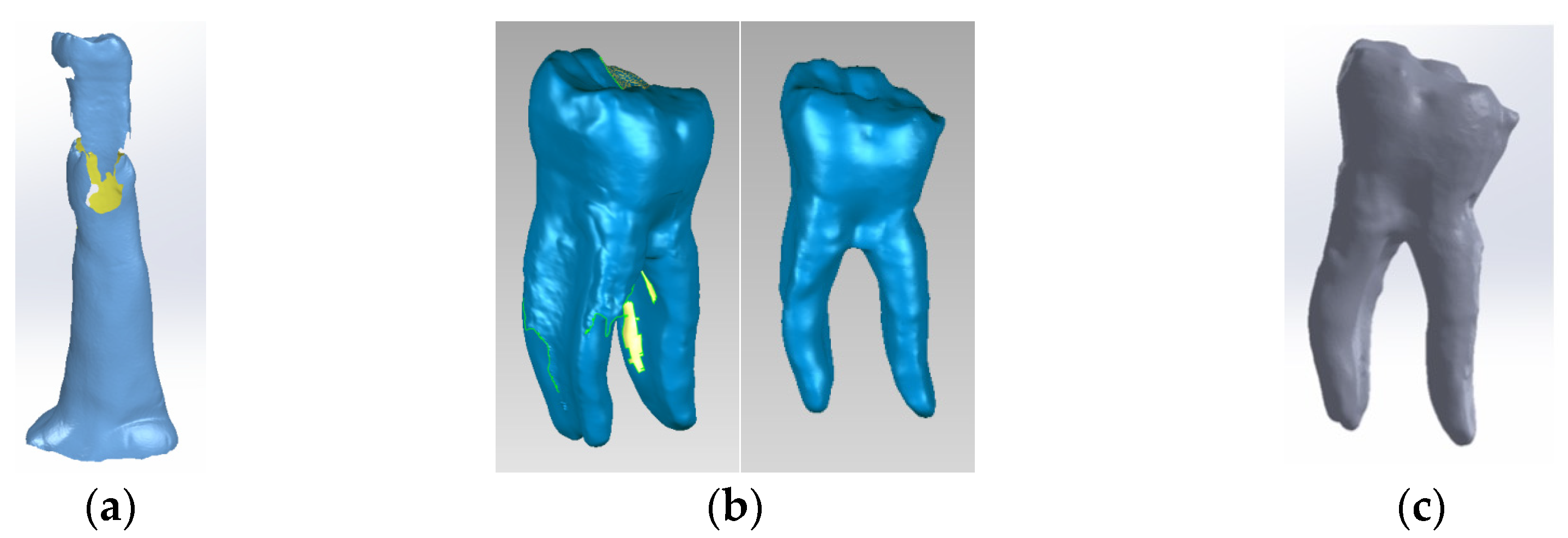

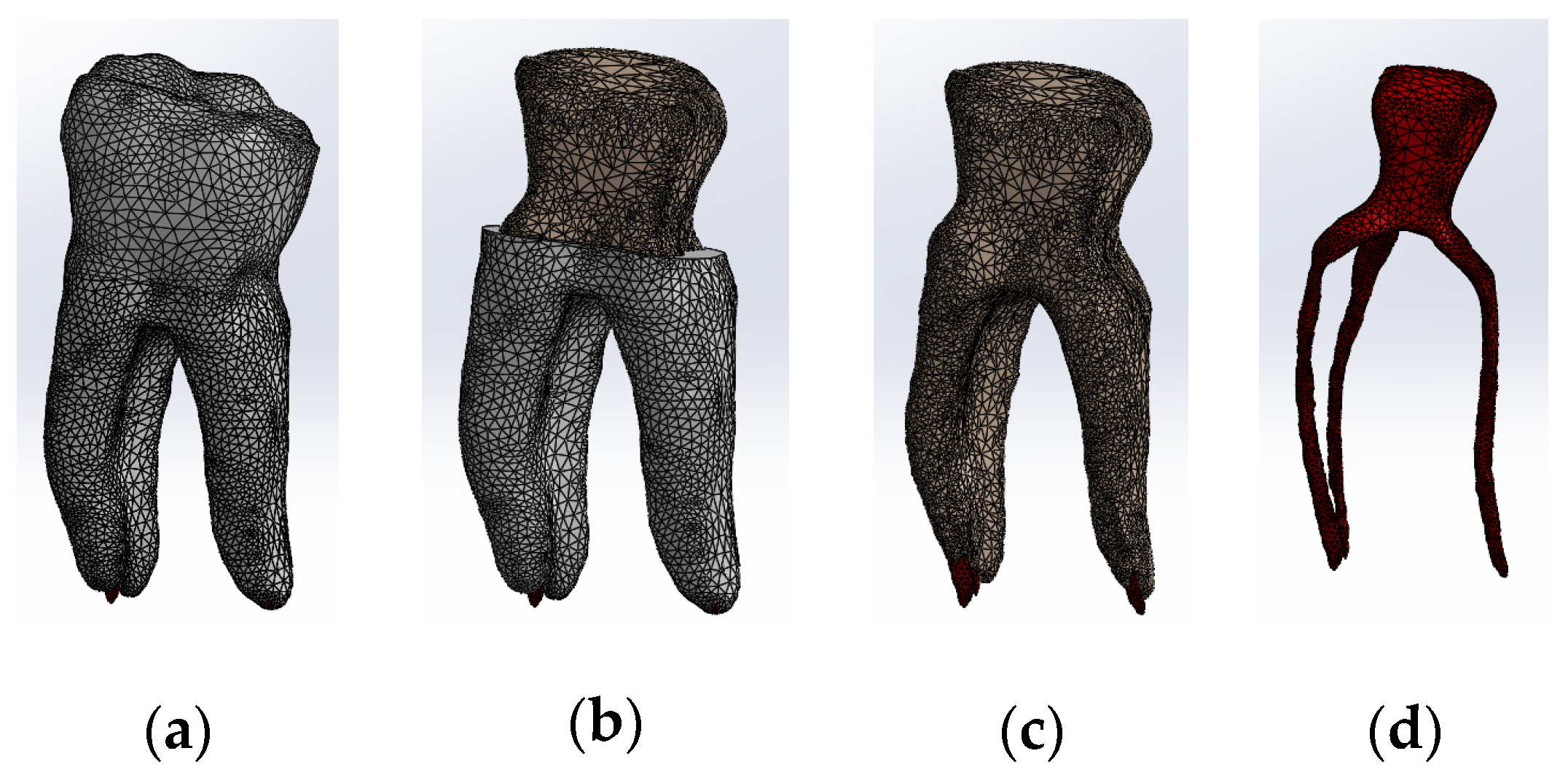

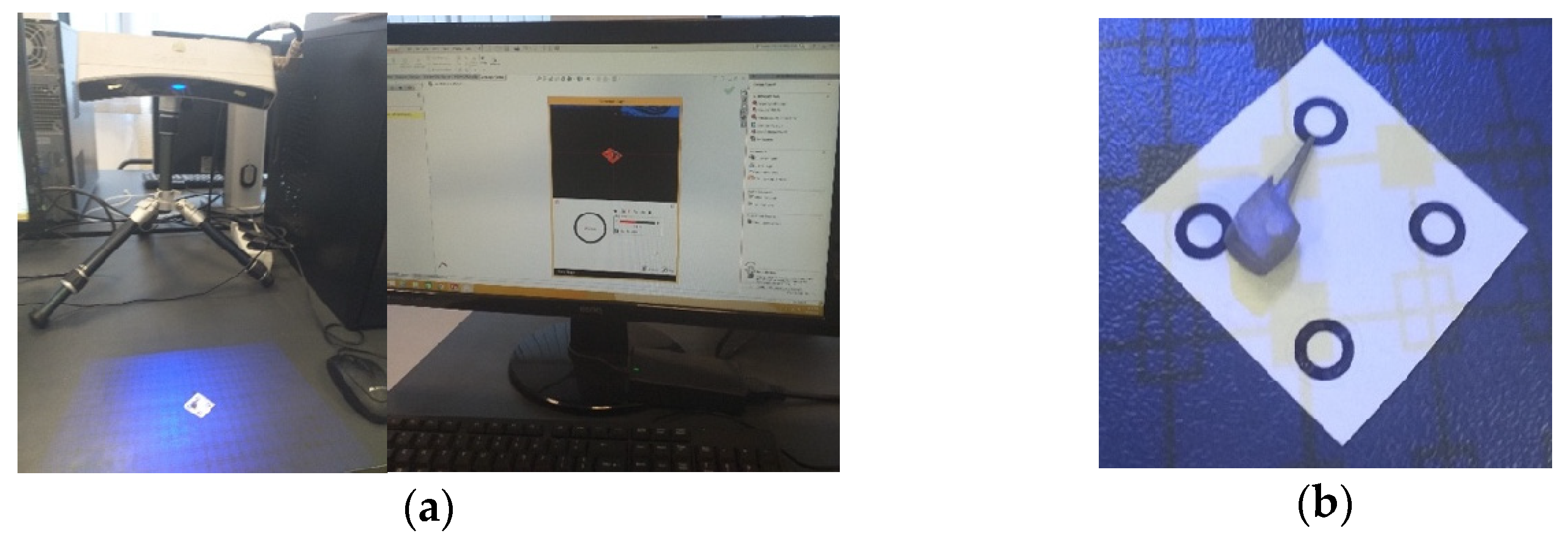





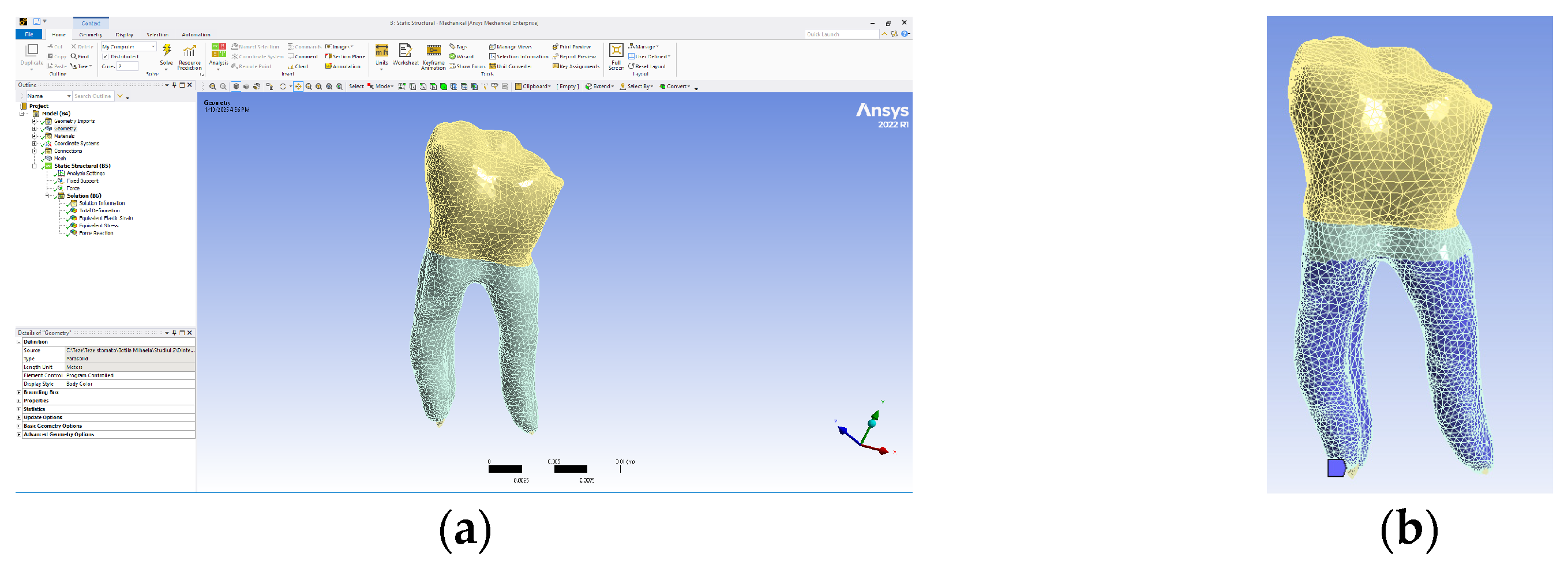
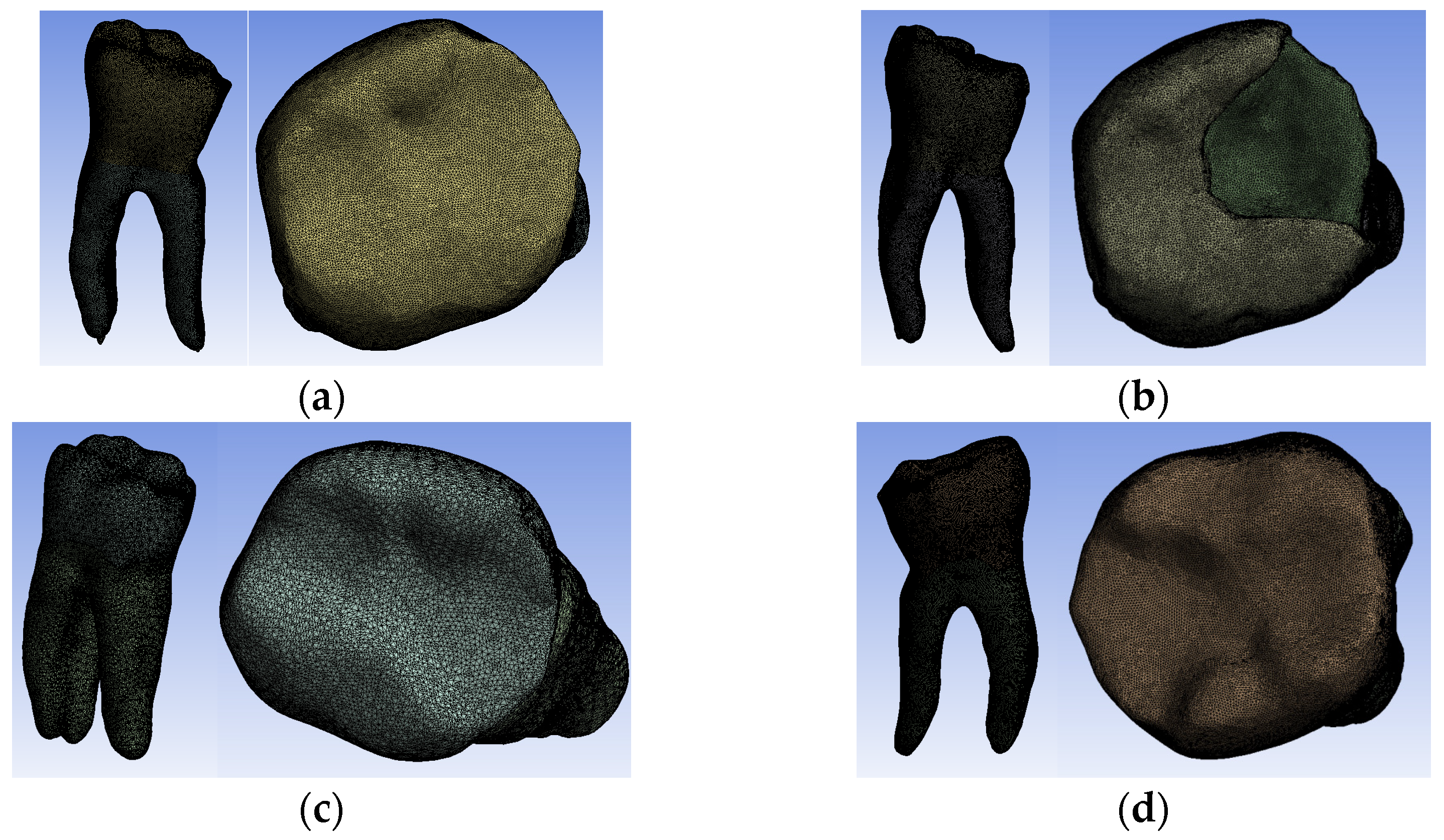
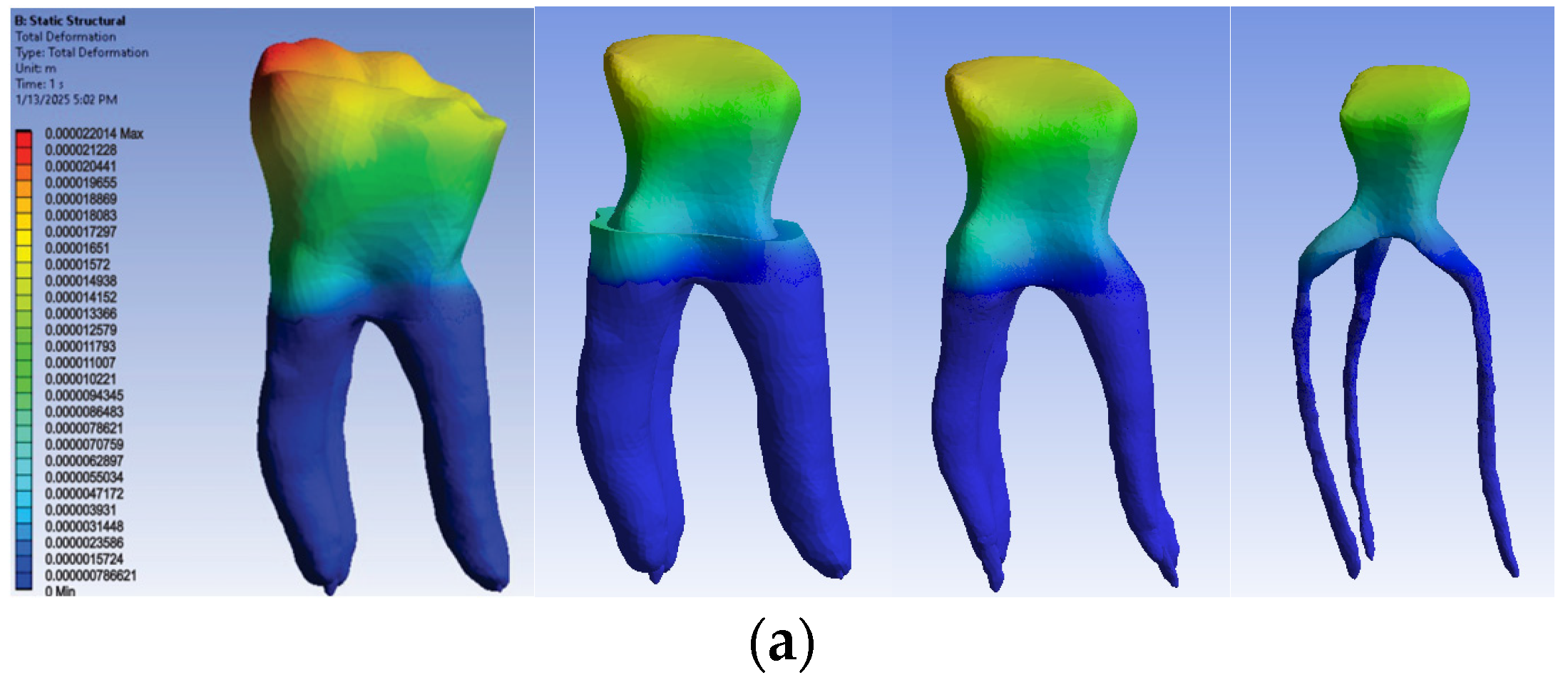
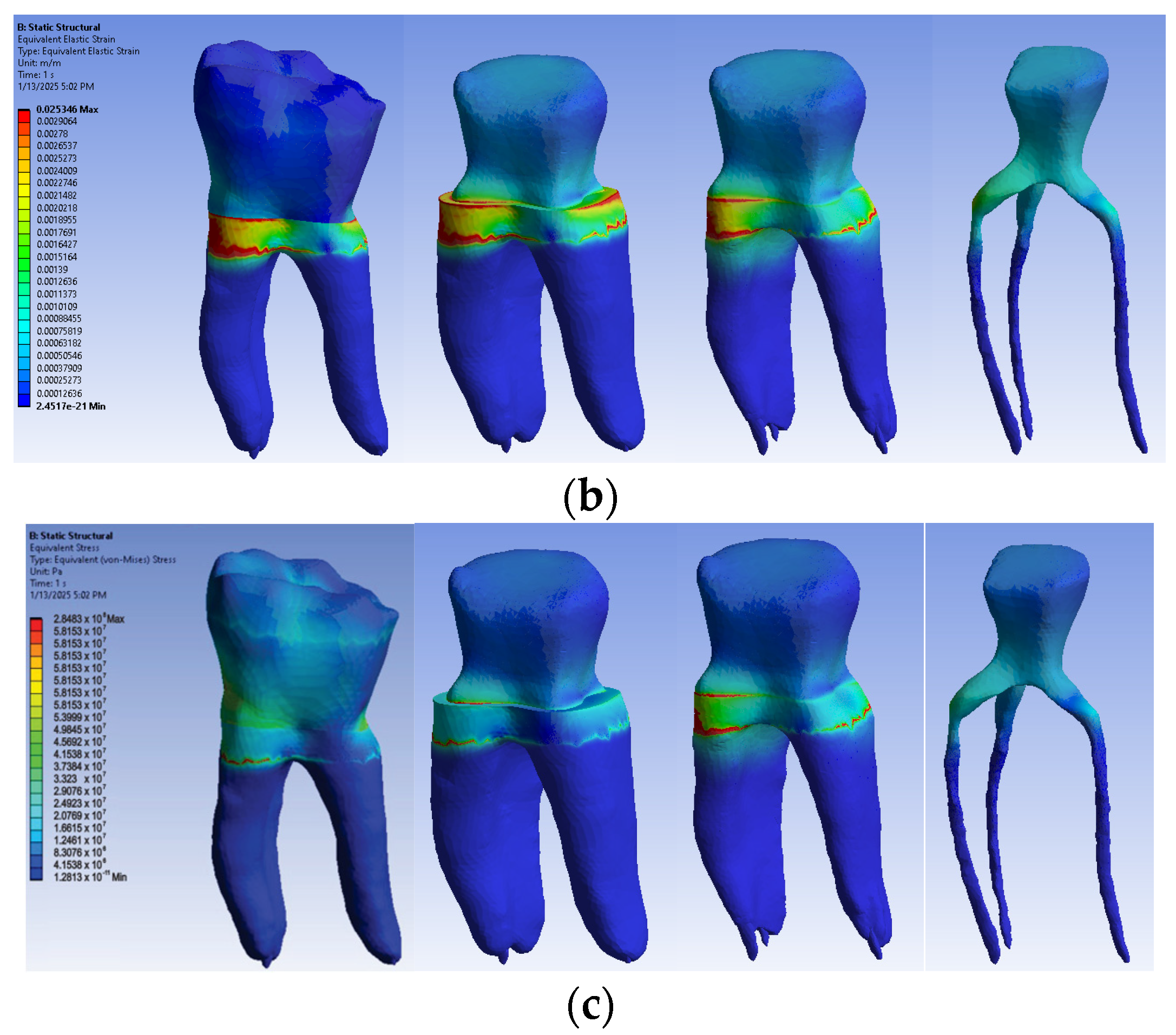
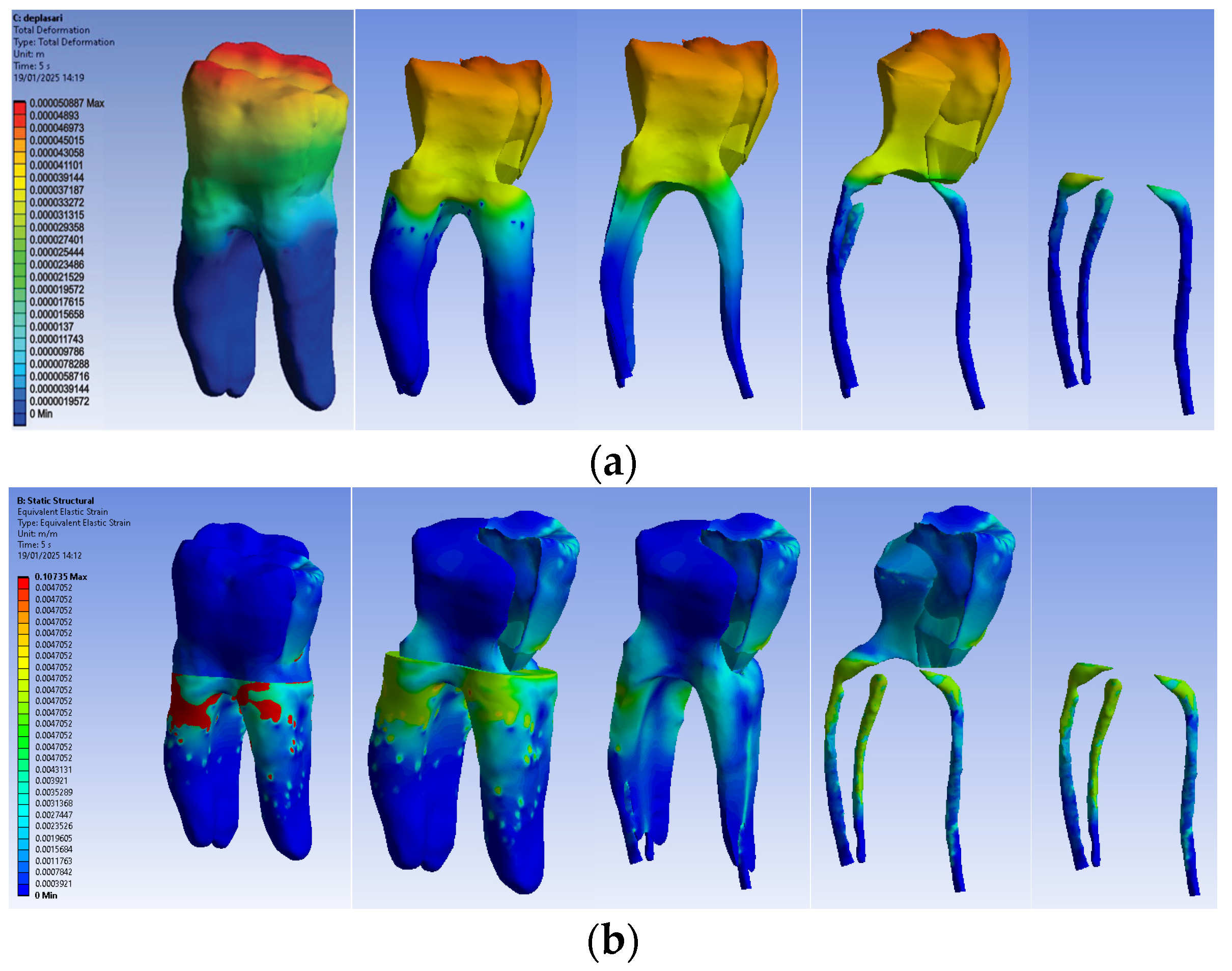
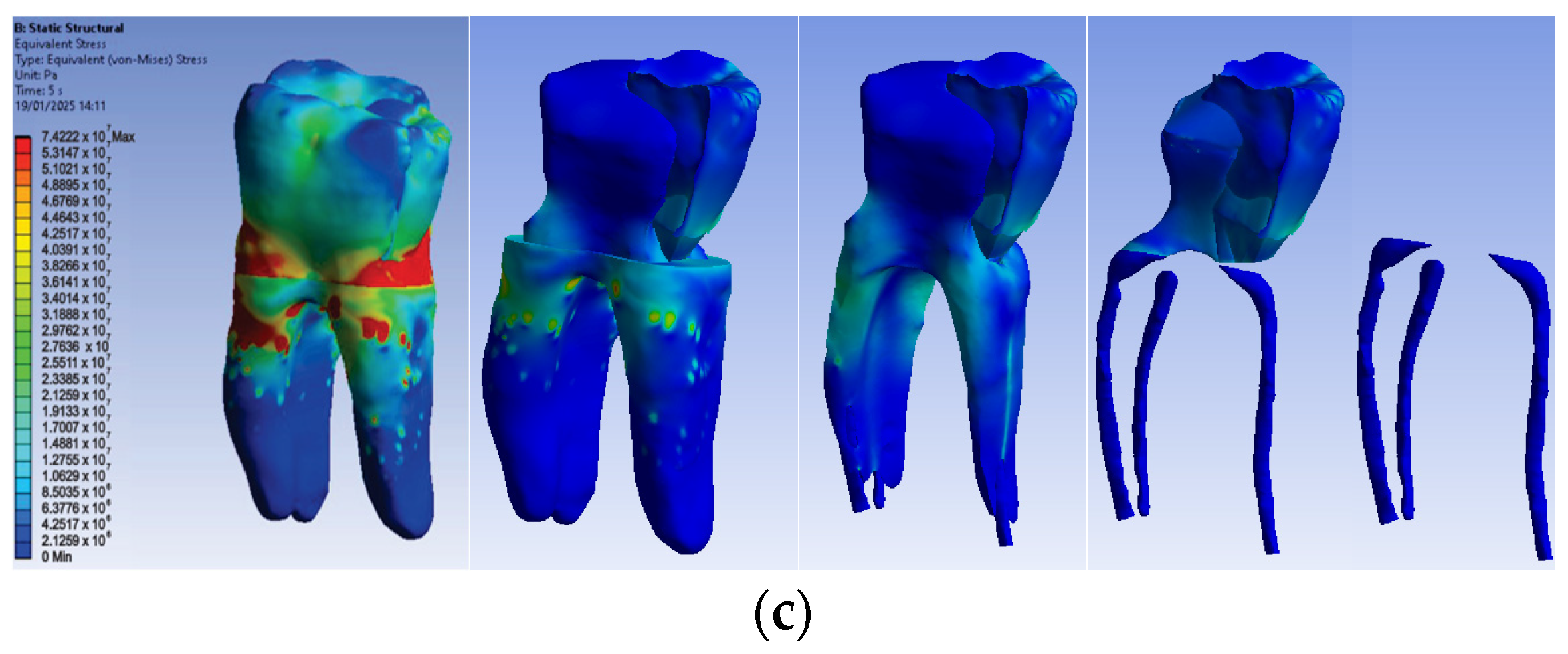
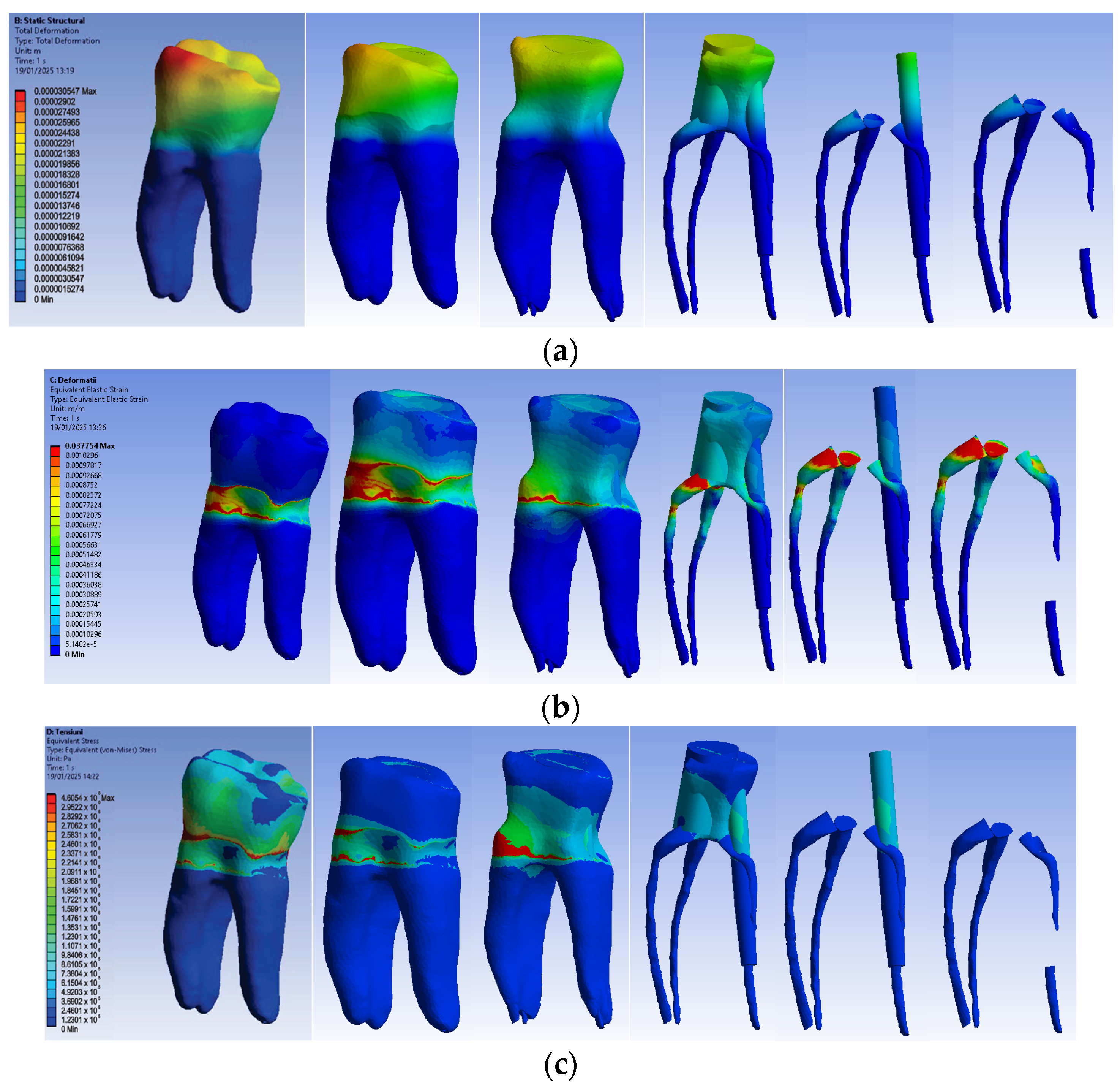
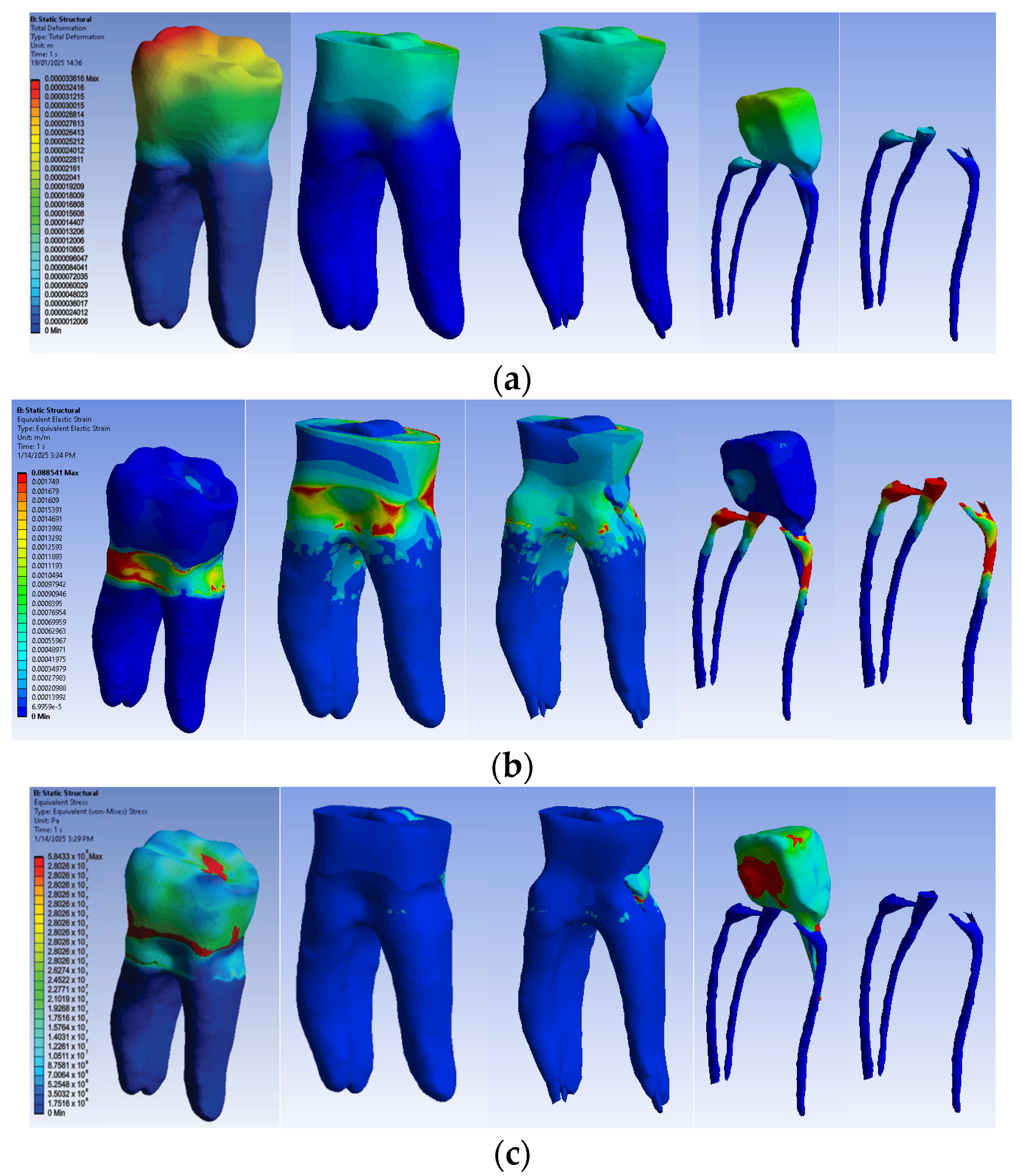

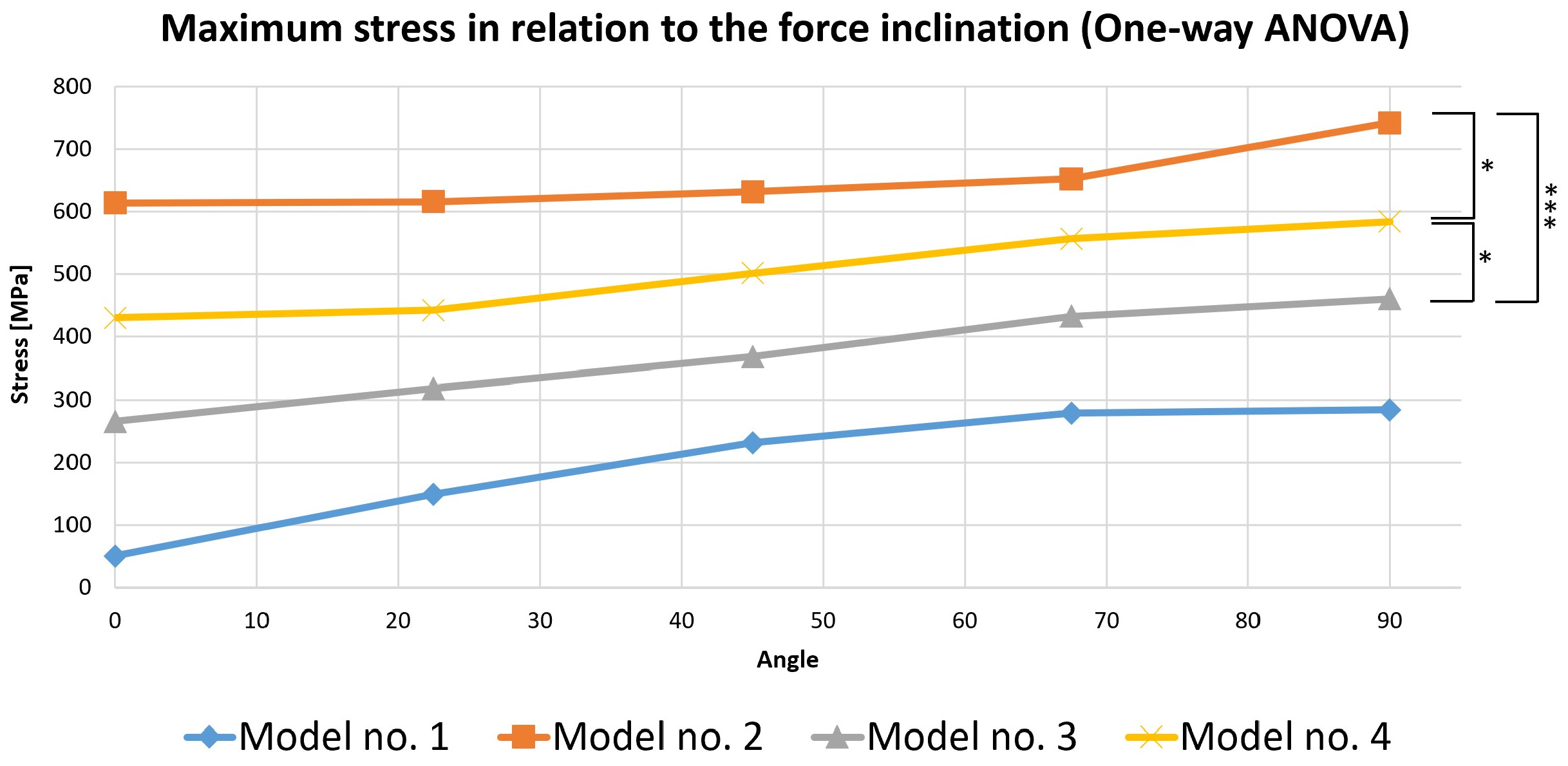
| Material | Density [kg/m3] | Modulus of Elasticity E [Pa] | Poisson’s Ratio |
|---|---|---|---|
| Enamel | 2958 | 8.41 × 1010 | 0.3 [40] |
| Dentin | 2140 | 1.86 × 1010 | 0.31 [40] |
| Dental pulp | 1000 | 2 × 106 | 0.45 [40] |
| Cementum | 2063 | 1.55 × 109 | 0.31 [41,42] |
| Gutta-percha | 1100 | 6.9 × 106 | 0.45 [40] |
| Composite | 1151.9 | 1.277 × 1010 | 0.31 [40] |
| Fiberglass post | 2000 | 4 × 1010 | 0.26 [43] |
| Zirconia | 4650 | 2.05 × 1011 | 0.22 [44] |
| Chromium–nickel alloy | 8500 | 2.1 × 1011 | 0.31 [45] |
| Model No. 1 | Model No. 2 | Model No. 3 | Model No. 4 | |
|---|---|---|---|---|
| Displacements [m] | 0.00002201 | 0.000050887 | 0.000030547 | 0.000033614 |
| Strains [m/m] | 0.025346 | 0.10735 | 0.037754 | 0.088541 |
| Stress [MPa] | 284.83 | 742.22 | 460.54 | 584.33 |
| Material/Tissue | Values Obtained | Unit of Measure | Model No. 1 | Model No. 2 | Model No. 3 | Model No. 4 |
|---|---|---|---|---|---|---|
| Enamel | Reference value 179 MPa [46] | t(s) | 3.63 | 3.77 | - | - |
| F(N) | 581.94 | 604.11 | - | - | ||
| Maximum values obtained | t(s) | 5 | 5 | - | - | |
| F(N) | 800 | 800 | - | - | ||
| MPa | 246.07 | 237.04 | - | - | ||
| Dentin | Reference value 212 MPa [46] | t(s) | 3.77 | 2.89 | ||
| F(N) | 604.11 | 462.90 | ||||
| Maximum values obtained | t(s) | 5 | 5 | 5 | 5 | |
| F(N) | 800 | 800 | 800 | 800 | ||
| MPa | 284.83 | 375.02 | 63.48 | 158.81 | ||
| Composite | Reference value 150 MPa [46] | t(s) | - | - | ||
| F(N) | - | - | ||||
| Maximum values obtained | t(s) | - | 5 | 5 | 5 | |
| F(N) | - | 800 | 800 | 800 | ||
| MPa | - | 114.46 | 3.08 | - | ||
| Fiberglass post | Reference value 879 MPa [46] | t(s) | - | - | ||
| F(N) | - | - | ||||
| Maximum values obtained | t(s) | - | - | 5 | 5 | |
| F(N) | - | - | 800 | 800 | ||
| MPa | - | - | 1.99 | - | ||
| Cast post (Cr-Ni alloy) | Reference value 900 MPa [46] | t(s) | - | - | ||
| F(N) | - | - | ||||
| Maximum values obtained | t(s) | - | - | 5 | 5 | |
| F(N) | - | - | 800 | 800 | ||
| MPa | - | - | - | 82.64 | ||
| Zirconia crown | Reference value 1200 MPa [46] | t(s) | - | - | ||
| F(N) | - | - | ||||
| Maximum values obtained | t(s) | - | - | 5 | 5 | |
| F(N) | - | - | 800 | 800 | ||
| MPa | - | - | 460.54 | 584.33 |
Disclaimer/Publisher’s Note: The statements, opinions and data contained in all publications are solely those of the individual author(s) and contributor(s) and not of MDPI and/or the editor(s). MDPI and/or the editor(s) disclaim responsibility for any injury to people or property resulting from any ideas, methods, instructions or products referred to in the content. |
© 2025 by the authors. Licensee MDPI, Basel, Switzerland. This article is an open access article distributed under the terms and conditions of the Creative Commons Attribution (CC BY) license (https://creativecommons.org/licenses/by/4.0/).
Share and Cite
Brătoiu, M.-R.; Mercuț, R.; Iacov-Crăițoiu, M.M.; Scrieciu, M.; Măgureanu Murariu, C.; Stănuși, A.; Popa, D.L.; Mercuț, V. Stress Evaluation in Endodontically Treated Virtual Teeth Restored with Composite Fillings and Cast or Fiberglass Posts—A Finite Element Analysis. Biomedicines 2025, 13, 974. https://doi.org/10.3390/biomedicines13040974
Brătoiu M-R, Mercuț R, Iacov-Crăițoiu MM, Scrieciu M, Măgureanu Murariu C, Stănuși A, Popa DL, Mercuț V. Stress Evaluation in Endodontically Treated Virtual Teeth Restored with Composite Fillings and Cast or Fiberglass Posts—A Finite Element Analysis. Biomedicines. 2025; 13(4):974. https://doi.org/10.3390/biomedicines13040974
Chicago/Turabian StyleBrătoiu, Mihaela-Roxana, Răzvan Mercuț, Monica Mihaela Iacov-Crăițoiu, Monica Scrieciu, Cătălina Măgureanu Murariu, Andreea Stănuși, Dragoș Laurențiu Popa, and Veronica Mercuț. 2025. "Stress Evaluation in Endodontically Treated Virtual Teeth Restored with Composite Fillings and Cast or Fiberglass Posts—A Finite Element Analysis" Biomedicines 13, no. 4: 974. https://doi.org/10.3390/biomedicines13040974
APA StyleBrătoiu, M.-R., Mercuț, R., Iacov-Crăițoiu, M. M., Scrieciu, M., Măgureanu Murariu, C., Stănuși, A., Popa, D. L., & Mercuț, V. (2025). Stress Evaluation in Endodontically Treated Virtual Teeth Restored with Composite Fillings and Cast or Fiberglass Posts—A Finite Element Analysis. Biomedicines, 13(4), 974. https://doi.org/10.3390/biomedicines13040974







